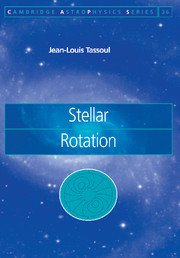6 - The early-type stars
Published online by Cambridge University Press: 15 August 2009
Summary
Introduction
An inspection of Figure 1.6 shows that the mean projected equatorial velocity of main-sequence stars increases slowly with spectral type, reaching a maximum of about 200 km s−1 in the late B-type stars. Thence, the mean velocity 〈ν sin i〉 decreases slowly for later spectral types until about F0, where it starts dropping precipitously through the F-star region. As is well known, this rapid transition to very small rotational velocities occurs at approximately the spectral type where subphotospheric convection zones become suddenly much deeper on the main sequence. Accordingly, because Sunlike stars are most likely to develop episodic mass ejections and magnetically channeled stellar winds, it is generally thought that these stars are losing mass – and, hence, angular momentum – as they slowly evolve on the main sequence. Postponing to Chapter 7 the study of these low-mass stars (M ≲ 1.5M⊙), in this chapter we shall consider stars more massive than the Sun (M ≲ 1.5M⊙) that are in radiative equilibrium in their surface layers.
In Chapter 4 we have already discussed the large-scale meridional currents and concomitant differential rotation in the radiative envelope of an early-type star, when the departures from spherical symmetry are not too large. Admittedly, the aim of that chapter was to develop a clear understanding of the many hydrodynamical phenomena that arise in a rotating star. In the following sections of this chapter we shall instead examine a selection of practical topics dealing with rotation, meridional circulation, and turbulence in the early-type stars.
Information
- Type
- Chapter
- Information
- Stellar Rotation , pp. 162 - 189Publisher: Cambridge University PressPrint publication year: 2000
